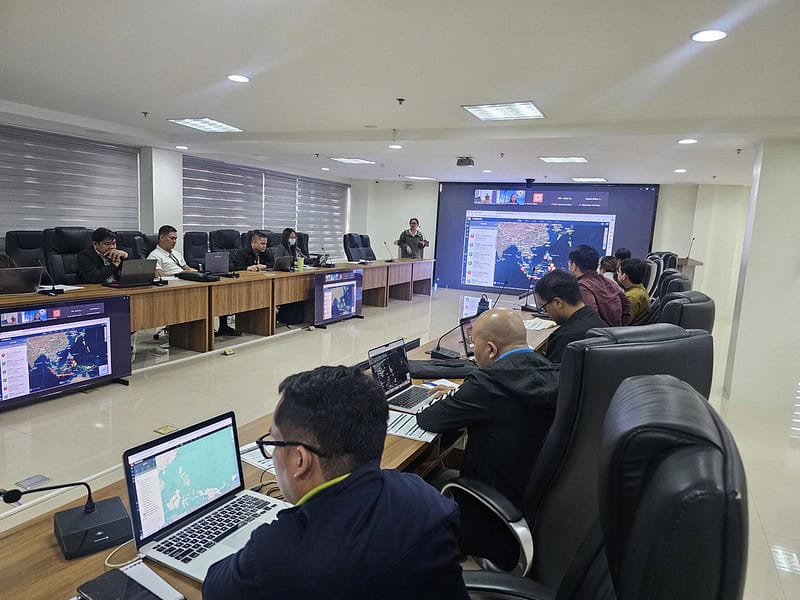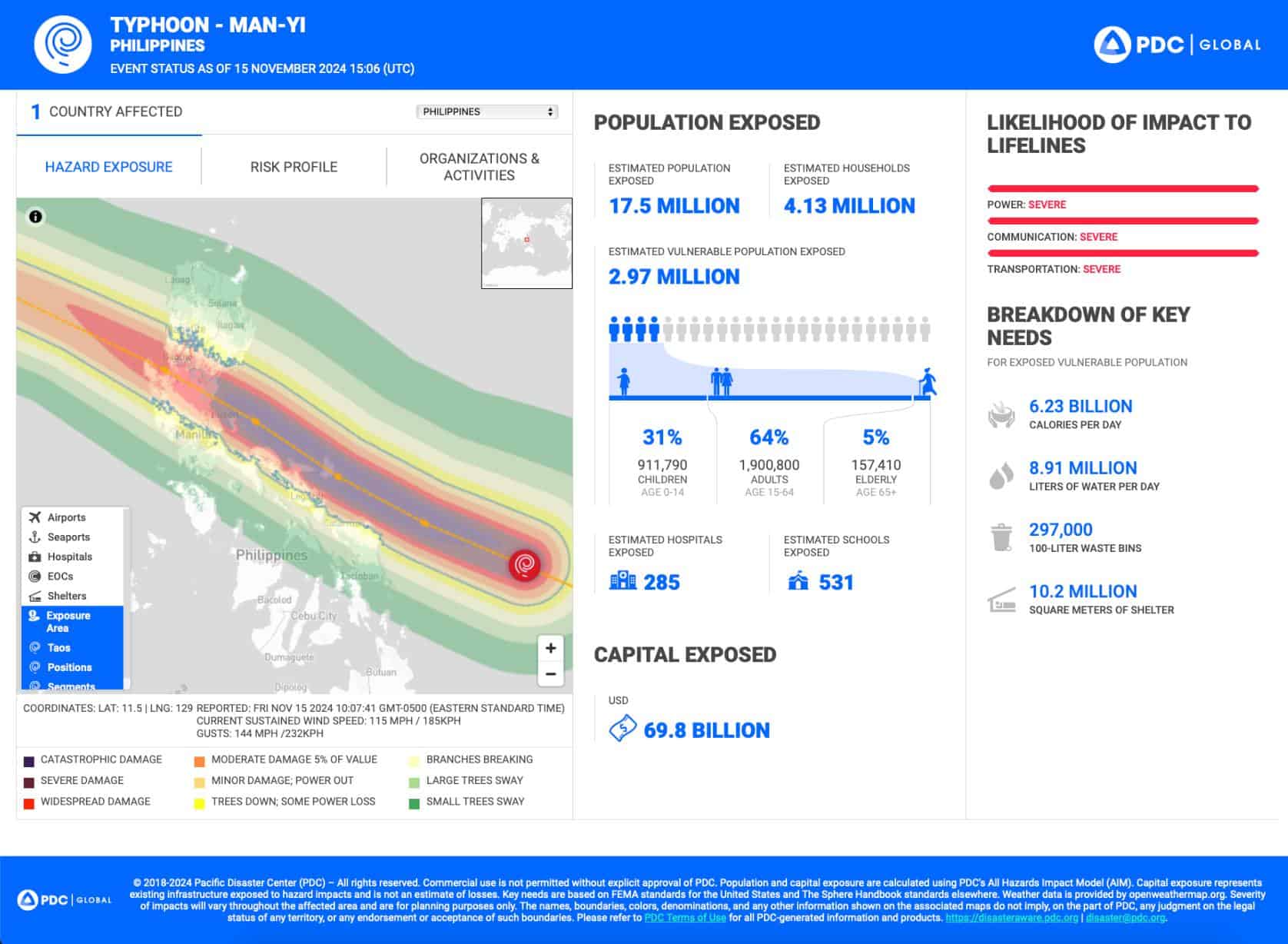PDC reunites with partners in Barbados for Tradewinds 2024 multinational exercise
After concluding a year-long engagement with Barbados in which the Pacific Disaster Center (PDC)...

Hurricane Melissa latest impacts, updates, and response efforts can be accesses by disaster managers via DisasterAWARE Pro.

In 2024, the Philippines was whiplashed by an unprecedented series of six consecutive typhoons in 30 days includin Super Typhoon Man-yi (Pepito), Typhoon Kong-rey (Leon), and Tropical Storm Trami—causing widespread damage and displacement and affecting over 13 million people.
Photo credit: CNN World
Manila, Philippines—Every year, the tropical Pacific region navigates increasingly severe typhoon seasons, with powerful storms that bring fierce winds, heavy rain, flooding, and storm surges across the region.
None are more familiar with these phenomena than the Philippines, which is especially vulnerable to typhoons due to the vast number of coastal areas exposed to the devastating pathways of the storms year-round. During the 2024 season alone, the nation suffered loss of life, millions of dollars in structural damage, and serious economic impacts as a result of a number of powerful storm events.
Being able to track and predict the likely impacts of these storms and provide early warning is essential to saving lives. Through a long-term partnership between the Pacific Disaster Center (PDC) and the Philippines Office of Civil Defense (OCD), the capacity to monitor hazards and take early action has been greatly enhanced in recent years.
A custom early warning and risk intelligence platform known as PhilAWARE, deployed in 2020 by PDC and powered by its core DisasterAWARE platform, provides near real-time warnings and analytical insights ahead of tropical cyclone landfall. This fast and accurate information aids disaster management operators with the identification and prepositioning of resources to protect communities, as well as ensures community awareness and preparedness prior to impact.

Analytics powered by PDC’s DisasterAWARE were used by the Philippines to prepare for Typhoon Man-Yi impacts and to prepare communities ahead of landfall.
Photo credit: PDC
 79.5 Million
79.5 Million
or 80.1% of the total population is exposed to typhoons
 Ranked 12th
Ranked 12th
in the Asia Pacific region for vulnerability, with standard of living, marginalization, and access to information being some of the key driving forces.
Situation reports issued by the Philippines National Disaster Risk Reduction and Management Council (NDRRMC), describe the following impacts:
 13 Million
13 Millionaffected by typhoon impacts
 170+
170+total fatalities from typhoons
 16k+
16k+homes destroyed
 P$22 Billion+
P$22 Billion+economic losses
The PhilAWARE system provides real-time information about numerous hazard types and is so vital to the Philippines OCD and national disaster risk reduction goals that it was formally institutionalized into the nation’s 2024 National Disaster Response Plan and 2024 National Disaster Risk Reduction Center and Management Operations Center Standard Operating Procedures and Guidelines.
According to OCD’s 2024 plan, “This integrated multi-hazard monitoring and early warning platform, an ICT-enabled decision support tool, aims to assist the NDRRMC Operations Center in pre-disaster, response, and post-disaster activities.
Beyond hazard monitoring, the PhilAWARE System is employed for creating incident maps and situation overviews through visual and interactive maps of various disaster incidents…it aims to address gaps in the country’s digitalization of disaster management services, serving as an integrated multi-hazard monitoring and early warning platform for decision makers and disaster managers.”
Some of the newest capabilities offered by PhilAWARE, deployed in 2024 in collaboration with PDC, include automated hazard information from the Philippine Institute of Volcanology and Seismology (PHIVOLCS) and the Philippine Atmospheric, Geophysical and Astronomical Services Administration (PAGASA). This information enhances the accuracy and timeliness of hydrological, meteorological, and geophysical data available in real-time through PhilAWARE to support OCD operations. The custom system also pulls in other relevant national data to support decision making such as critical infrastructure, population risk and vulnerability data, locations of schools, hospitals, ports, seaports, emergency response facilities, and a wealth of other national data to increase OCD’s understanding of hazard impacts.
Since its deployment, PhilAWARE has become a vital tool for disaster management in the Philippines. In 2024, the National Disaster Risk Reduction and Management Council (NDRRMC) conducted regular disaster preparedness and response meetings, leveraging PhilAWARE for a Pre-Disaster Risk Assessment conducted under the leadership of Asec Cesar Idio of the Operations Service. The system was used to assess risk, evaluate, and plan courses of action. As a multi-hazard system, in recent months, OCD’s Operations Center has also leveraged PhilAWARE for other hazard events including supporting forest fire response in Nueva Era, Ilocos Norte, as well as helping them determine potential impacts following a magnitude 5.0 earthquake in Santa Catalina, Ilocos Sur.
“Following our recent project completion and system handover, we are pleased to see the PhilAWARE system being operationally used to support OCD monitoring and response during the Philippines’ recent storm season. We are equally proud that our partnership with OCD has provided such tangible disaster management outcomes and that the nation is even better prepared for the 2025 typhoon season,” said Chris Chiesa, PDC Director of Early Warning Solutions.
In preparation for the impending storm season, OCD mobilized its cadre of skilled PhilAWARE trainers to deliver use training to the regional OCD offices, building subnational capacity to access and utilize the system for monitoring and response, as well as enhancing national-regional coordination. With these tools in hand, the Philippines is better prepared to orchestrate a quick and coordinated response to typhoons in 2025, dramatically reducing the impacts of disasters in the coming season. These tools also support the other member agencies of the NDRRMC, along with local governments and humanitarian partners, helping communities prepare through drills, public alerts, and response planning.
Get quarterly updates about PDC innovations and projects!
ABOUT PDC
Pacific Disaster Center (PDC) is a leading scientific innovator of global risk reduction science and technology. As a University of Hawai’i applied science and research center, our work intersects with a variety of government, community, academic, and scientific organizations at home and around the world to build resilience to natural and man-made hazards—enhancing the capacity to quickly and accurately anticipate and prepare for new and emerging threats. Our innovations in multi-hazard early warning systems, predictive analytics, data science, and machine learning provide decision-makers with the powerful tools and insights they need to navigate today’s complex and interconnected risk landscape.
May 14, 2024 | Early Warning, Exercises and Training
After concluding a year-long engagement with Barbados in which the Pacific Disaster Center (PDC)...
May 3, 2024 | Advanced Analytics, Early Warning, Partnerships
Geneva, Switzerland—During the week of May 6-10, 2024, participants at the U.N. Humanitarian Networks and Partnerships Weeks (HNPW) forum in Geneva, Switzerland will get a firsthand look at how PDC is spearheading transformative efforts within the “Early Warnings for All” initiative, including its advanced analytics
Nov 8, 2023 | Early Warning
Singapore’s Changi Regional Humanitarian Assistance and Disaster Relief (HADR) Coordination Centre...
Oct 26, 2023 | Early Warning, Latest Stories
Communities worldwide now have access to a powerful tool to increase their awareness of landslide...
Sep 20, 2023 | Early Warning
Port Alfred, South Africa—At the invitation of The International Emergency Management Society...
May 11, 2023 | Early Warning
Dili, Timor-Leste—Timor–Leste has just reached new milestones towards the United Nations (UN)...